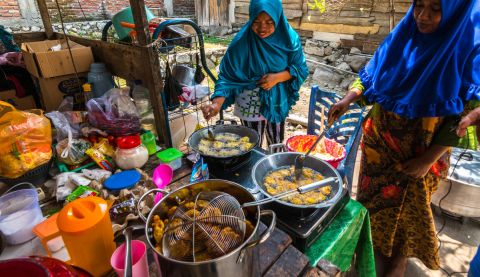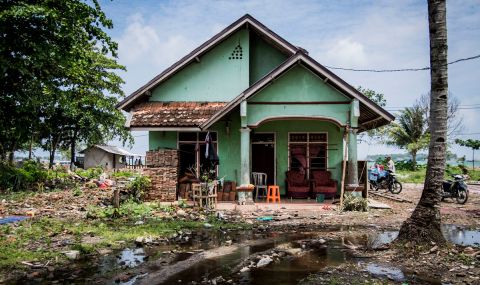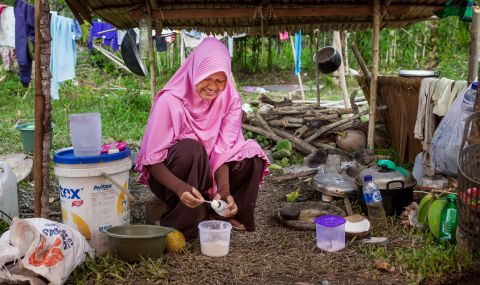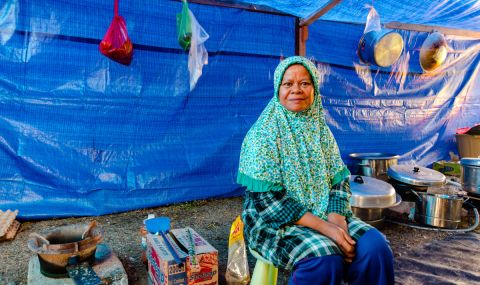The Indonesia earthquake and tsunami: why women’s leadership worked
27 September 2019
28th September marks one year since a series of powerful earthquakes struck the Central Sulawesi province of Indonesia, triggering a tsunami resulting in significant damage and loss of life. Our new research shows how women's leadership made an incredible difference in the aftermath.

Women's leadership was transformative in the aftermath of the Indonesia tsunami. Photo: ActionAid
In the aftermath of the earthquake and tsunami that struck Indonesia in September 2018, ActionAid was one of the first organisations to establish its presence on the ground.
We were part of a 'new' approach for the humanitarian sector, as the Indonesian government responded quickly to establish its leadership in the response, and confirmed that assistance would be channelled through national or local humanitarian partners. This forced international actors to rethink and reposition their roles.
In the first two weeks, ActionAid’s national entity, YAPPIKA-ActionAid, worked with a network of local organisations called ‘Sulteng Bergerak’ to bring relief to at least 60,000 people.
YAPPIKA-ActionAid prioritised women’s leadership within the response, working with three women-led partners (WALHI Central Sulawesi, Sikola Mombine (SM) and Solidaritas Perampuan) to establish women-friendly spaces, distribute non-food items, and provide shelter for affected communities.
In our latest research, we explore the transformative power of women-led localisation in disaster response, and consider the challenges this approach faces - now and in the future. Download and read the full report here.
Why women's leadership?
ActionAid has been promoting women’s leadership in emergencies for many years.
But we are still often asked: why women?
What difference can it possibly make having women’s leadership? Surely, it’s better just to get on with the response and worry about women’s rights after we have managed to meet all the basic needs?
The answer for us is simple. Prioritising women’s leadership is not only the right thing to do, but the most practical thing to do.
Women and women-led organisations bring valuable skills and assets to localised humanitarian action. They are often able to gain access to hard-to-reach communities and those most marginalised within them.
They bring a strong understanding of the local context and the needs and realities of women, girls and the community as a whole, and they offer crucial insight on how to engage with the community.
And finally, women’s leadership can be transformative.
We enable women to find the power within themselves and collectively challenge negative power structures.

One year on: the aftermath of the Indonesia tsunami .
Why is women's leadership important for 'localisation'?
Ideas about localising humanitarian aid have gained traction over the last two years, since the 2016 World Humanitarian Summit, when the Secretary General called for humanitarian action to be ‘as local as possible, as international as necessary’.
There's no single definition of 'localisation', but there is broad agreement that the humanitarian sector is still failing to meaningfully shift power and resources to local women and women-led organisations - despite the ambitious plans that many share.
Local women-led organisations still receive a fraction of overall humanitarian funding. And women are still grossly underrepresented when it comes to decision-making.
But it's becoming ever-more important to put women and girls at the heart of any response. As we recently asserted in a joint report with CARE, "listening to women and girls, and protecting and respecting their rights, can no longer be seen as an “optional” aspect of a humanitarian response."
ActionAid’s definition of ‘women-led localisation’ highlights that localisation must be a transformative process which puts women and girls at its centre and values the significant role of women’s leadership at a local level as part of humanitarian action.
It also crucially acknowledges the multiple responsibilities that women face, including unpaid care work, and advocates for supportive and practical solutions to address these barriers.
Our research and what we found
Building on the extensive work of ActionAid and our partners, we worked in partnership with YAPPIKA-ActionAid, local women and women-led organisations to design a piece of research to understand, within the unique parameters of the Central Sulawesi response, the challenges and opportunities for women-led localisation.
We found that, despite limited visibility and acknowledgement within formal response efforts, diverse local women and women-led organisations were some of the first actors to mobilise and respond on the ground in the aftermath of the disaster.
Women leveraged their trusted positions in communities, and existing connections and networks, to move quickly and effectively.
They were able to provide key services for the community, including supporting evacuation processes and food and clothes distributions, acting as medical personnel and supporting school reconstruction.
Before the disaster, I was only at home taking care of my children and had never taken part in activities outside the home. Now I’m participating in livelihood activities” - Woman responder from a community in Palu
Local women and women-led organisations also played a critical role in identifying and supporting the needs of women and girls in the community. For example, in setting up and managing safe spaces (including Women Friendly Spaces and Women Friendly Tents), delivering psychosocial services and support, and creating opportunities for women and children to come together and share their experiences and concerns.
They have also played a key role in raising the profile of, and advocating on, key concerns with local authorities.

Wahida prepares milk for her son at a shelter supported by ActionAid, following the Indonesia earthquake .
Challenges and opportunities
Despite these widespread examples of women-led successes in Central Sulawesi, our research identified several opportunities and challenges.
We found that, in some cases, existing gender inequalities had been exacerbated and disrupted following the Central Sulawesi disaster.
Some women described positively the new opportunities that had been created for them to step up and take on new responsibilities. But others highlighted their increased workloads (which they had to balance alongside unpaid care work), and some increases in gender-based violence.
Formal decision-making continue structures continue to be dominated by men.
In some cases, we found women-led organisations who were able to influence decision-making, but even here, patriarchal and elite power may still exist, and there were big differences in women’s confidence and perception of their influence depending on which area they lived in.
We must fight together so that women can build their own skills and confidence. Some [women] are still not confident and worry if they make a mistake” - Women-led organisation, Palu
Our research found that local women and women-led organisations have diverse skills, knowledge and networks that are an enormous asset in humanitarian response (and preparedness and recovery work).
But, a lack of ‘humanitarian expertise’ and operational capacity challenges limited their capacity to engage.
Representatives from some women-led organisations emphasised that in focusing on meeting new ‘humanitarian needs’, their longer-term women’s rights work, including on issues like conflict resolution and women’s land rights, was put on hold.

Ros, a volunteer cook, distributing nutritious food in the aftermath of the disaster .
Our research: the recommendations
- Humanitarian agencies and donors need to understand the gendered norms and unequal power relations which shape women’s lives prior to, during and after a humanitarian crisis.
- Humanitarian agencies and donors should prioritise women’s voices, perspectives and skills within humanitarian architecture and decision-making spaces as well as in their own organisations, ensuring the participation of local women’s organisations.
- Humanitarian agencies and donors should strengthen local partner capacity to respond to the unique scale, pace and demands of humanitarian response.
- Government disaster management actors should foster effective dialogue and collaboration between governmental and non-governmental organisations operating at both a national and local level.
Download the full report
Thank you to everyone who helped make this research possible. Download and read the full report here.



